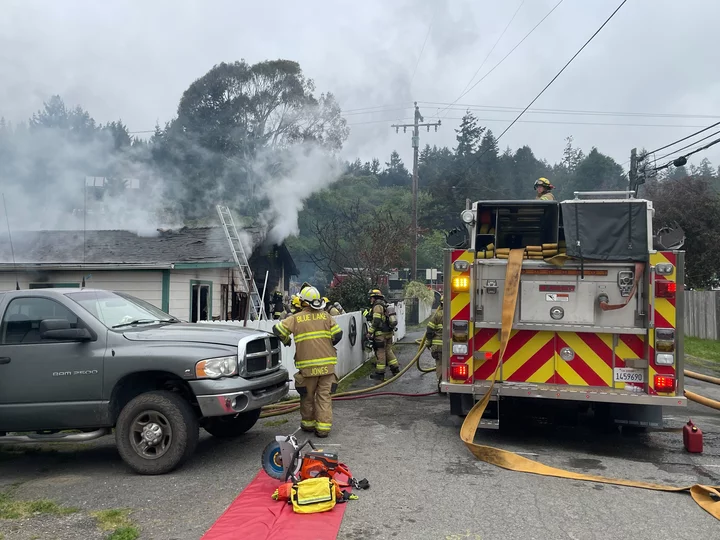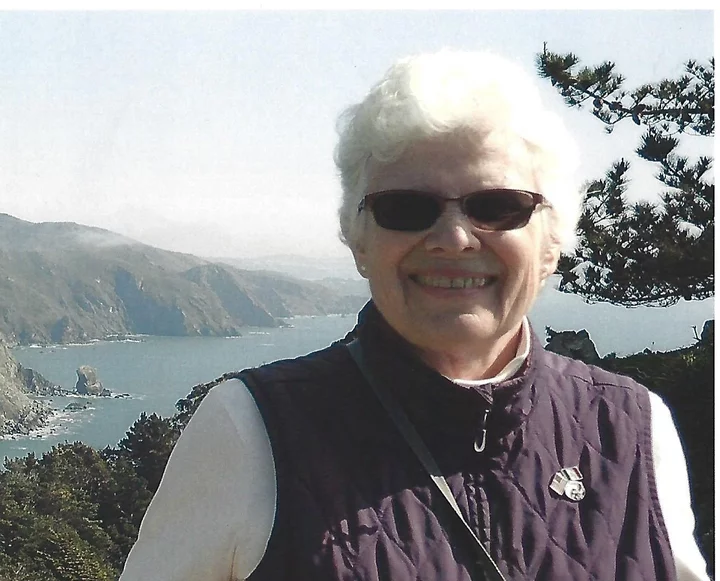Federal Judge Tosses Class Action Suit Challenging Humboldt County’s Cannabis Code Enforcement Processes
Ryan Burns / Monday, May 15, 2023 @ 5:26 p.m. / Courts
Detail of a county notice of violation.
###
United State Magistrate Judge Robert M. Illman on Friday dismissed a federal class action lawsuit brought by the nonprofit Institute for Justice on behalf of a group of Southern Humboldt property owners who alleged that the county’s cannabis code enforcement practices were illegal.
Specifically, the claim argued that the county’s administrative processes to abate illegal weed grows violated the plaintiffs’ constitutional right to due process; levied exorbitant and unjustified fines and fees; and deprived plaintiffs of their alleged constitutional right to have a jury present at an administrative hearing.
The lawsuit, which was filed last year, named the County of Humboldt as a defendant along with all five county supervisors by name and county Planning Director John Ford, in their professional capacities.
Having read Judge Illman’s 52-page decision (a link to which you can find below), I think it’s fair to say he effectively laughed this case out of court. His ruling repeatedly and comprehensively rebukes the arguments put forward by plaintiffs’ attorneys, describing their reasoning variously as “implausible,” “baseless,” “unreasonable,” “ineffectual” and riddled with “gross mischaracterizations.”
Here’s just one example of his upbraiding:
Despite the [first amended complaint’s] length, overlooking its irrelevant content, and its conclusory and implausible assertions – and in light of the materials of which the court is taking judicial notice – it becomes clear … that the underlying facts do not, and simply can not, entitle these Plaintiffs to any relief against these Defendants.
Here’s another:
Spanning 70 pages, with more than 600 numbered paragraphs, the [complaint] is overwhelmingly dominated by legal arguments couched as factual allegations, unreasonable inferences, unwarranted deductions, conclusory assertions, unjustified labels, and hyperbole. As to the relatively small number of paragraphs that do contain actual allegations of fact, the vast majority of that content is either irrelevant or simply implausible.
He takes the plaintiffs’ allegations one by one. Regarding a claim that they had been subjected to “excessive fines and fees,” Judge Illman proceeds to describe each one’s individual circumstances before noting, “No party has actually paid a fine.”
Regarding a claim that the county routinely denies land-use permits to landowners with outstanding abatement orders, Judge Illman writes, “Plaintiffs concede that they have not actually received any such final decisions by having had any such land-use permit applications rejected.”
Regarding the demand for a jury trial he writes, “[T]here is no right to a jury trial in the sort of administrative hearing at issue here – something which Plaintiffs appear to vaguely concede.”
Furthermore, he observes, the county’s code enforcement regulatory framework “expressly provides for full-fledged judicial review after the conclusion of the administrative phase of the proceedings.”
The allegation that the plaintiffs have been denied due process, meanwhile, gets dismissed for failure to state a claim. Attorneys for the plaintiffs listed ten examples of the county’s alleged failure to provide adequate notice or an opportunity to be heard, but Judge Illman concludes, “all either implausible, irrelevant, conclusory, or are based on unreasonable inferences or unwarranted deductions.”
Ultimately he dismissed every last claim with prejudice, meaning the suit cannot simply be refiled in U.S. District Court’s Northern District of California, where it was heard.
But in a press release published on Redheaded Blackbelt, attorneys with the Institute for Justice vow to appeal the decision to the Ninth U.S. Circuit Court of Appeals.
The press release says the judge “accepted as true many of the county’s factually incorrect statements,” and attorney Jared McClain adds, “We disagree with the court’s decision and will continue to fight for justice on appeal, ensuring that the rights of Humboldt County property owners are protected.”
In an emailed statement, Humboldt County Public Information Specialist Cati Gallardo said, “While we were disappointed that a small number of residents chose this route in an attempt to resolve their existing violations, we are pleased by the court’s decision. The United States Magistrate Judge is direct in the rationale for ruling on each count, and we appreciate the clarity provided by the court. We look forward to resuming collaboration with property owners to resolve these and other open cannabis-related cases.”
###
BOOKED
Yesterday: 11 felonies, 16 misdemeanors, 0 infractions
JUDGED
Humboldt County Superior Court Calendar: Yesterday
CHP REPORTS
No current incidents
ELSEWHERE
RHBB: Catholic Hospital Denies It Violated CA Law, Attorney General Makes Case For Abortion Protection
RHBB: Prescribed Burn Planned for the Huestis Rock Unit, Ft. Seward Area
RHBB: Green Diamond Prescribed Burning Notification for Today
Blue Lake Fire Says One Dog, Two Cats Missing in Today’s House Fire
LoCO Staff / Monday, May 15, 2023 @ 1:53 p.m. / Fire
Photo: Ryan Burns.
###
PREVIOUSLY:
###
Press release from Blue Lake Fire:
On May 15, 2023 at approximately 9:12am Blue Lake Fire Department was dispatched to a reported residential structure fire at the 500 block of Hartman Street. Initial reports stated there was a possible explosion at the residence. One Blue Lake Engine responded as well as the Blue Lake Chief. Upon arrival crews found a single story residential structure fully involved.
Firefighting operations established a defensive attack. It was determined that the “explosions” heard from the residence was the result of a large amount of ammunition present as scene. The Humboldt County Sherriff’s Office issued an evacuation order for the residents in the immediate area of Hartman and Blue Lake Boulevard. Fire personnel had the fire knocked down in approximately 35 minutes after the initial dispatch.
One dog was rescued from the structure, however, one dog and two cats were not accounted for at scene after firefighters looked through the home after the fire was controlled. Blue Lake’s Chief began to release mutual aid resources at approximately 11:00am; crews remained on scene for clean up until 12:30pm. The cause of the fire is still under investigation; at this time it is unclear as to what started the fire.
Blue Lake Fire would like to thank our allied partners for their assistance during this incident, Fieldbrook Fire, Arcata Fire, Humboldt Bay Fire, and Westhaven Fire. We would also like to thank CHP, PG&E and HCSO.
[UPDATED] Eureka Woman Dies at Moonstone Beach One Day After Graduating From Nursing School
Ryan Burns / Monday, May 15, 2023 @ 12:28 p.m. / News
###
Martina Scarfia, a 25-year-old Eureka woman who graduated from College of the Redwoods’ nursing school Saturday, died at Moonstone Beach Sunday afternoon despite rescue efforts from concerned onlookers and the U.S. Coast Guard.
While out surfing, Scarfia experienced an unknown medical emergency and lost consciousness, her older sister, Asia Autumn Scarfia-Ward, told the Outpost on Monday.
As first reported by Kym Kemp on Redheaded Blackbelt, the Coast Guard and other agencies were dispatched to Moonstone Beach Sunday afternoon in response to a 911 call regarding a surfer who’d been pulled from the ocean.
Trinidad resident Larisa King was at the beach with her husband at the time, and in an email to the Outpost she said that they and other beachgoers attempted to help Scarfia, who appeared unconscious.
“My husband and I saw what happened and assisted with contacting 911,” King said in her email, adding, “She was ultimately airlifted by coast guard helicopter after a period of approximately 30 minutes of chest compressions.”
Scarfia-Ward confirmed in a Facebook post this morning that her sister passed away Sunday.
“My beautiful baby sister took her last breath yesterday,” Scarfia-Ward wrote. (She gave the Outpost permission to share her message with the public.) “I am so proud of everything she has done and the amazing person she has become. She graduated from Nursing School with honors on Saturday. We celebrated as a family and paddled out together one last time until paradise. I love you Martina Scarfia.”
Scarfia was born in Nebraska but raised here in Humboldt County since 2000, her sister told the Outpost.
We have requested more information from the Coast Guard and the Humboldt County Sheriff’s Office. We will update this post as that information becomes available.
###
UPDATE, 1:55 p.m.:
From the Humboldt County Sheriff’s Office:
On May 14, 2023, at about 3:51 p.m., Humboldt County Sheriff’s deputies were dispatched to Moonstone Beach near Trinidad for the report of a surfer in distress.
According to witnesses, two women were surfing in the ocean when one of them, later identified as 25-year-old Martina Marie Scarfia of Eureka, reportedly became unattached from the surfboard and was overcome by waves. Another beachgoer was notified of the emergency and swam out to rescue Scarfia. She was recovered from the water and transported to a local hospital via helicopter by the U.S. Coast Guard Sector Humboldt Bay. Scarfia was later pronounced deceased.
An autopsy is in the process of being scheduled. Cause and manner of death remain under investigation, pending the results of the autopsy.
###
CORRECTION: This post has been updated to reflect that Scarfia lived in Eureka rather than Arcata.
‘Take Action for Mental Health’ Walk in Henderson Center Tomorrow Kicks Off Department of Health and Human Services’ ‘Everything Awareness Month’
LoCO Staff / Monday, May 15, 2023 @ 12:01 p.m. / Health
Press release from the Humboldt County Department of Health and Human Services:
There are lots of reasons to celebrate in May — Mental Health Awareness, CalFresh Awareness and Caregiver Appreciation, just to name a few.
On Tuesday, May 16, join your friends and neighbors for the Take Action for Mental Health Walk. Participants will meet up at the Hope Center, 2933 H St. in Eureka at 11:30 a.m. and walk to the Humboldt County Courthouse and back. Wear lime green to show your support. Snacks will be provided.
On Friday, May 19, the Wellness and Connection Barbecue is scheduled to take place at the Jefferson Community Park, 1000 B St. in Eureka, from 11 a.m. to 2 p.m. Hot dogs and vegetarian options will be provided.
Humboldt County Department of Health & Human Services (DHHS) Behavioral Health Director Emi Botzler-Rodgers said these community events go a long way toward ending stigma.
“Mental health is part of a whole person experience and just like physical illness, mental illness can occur at various times throughout all our lives,” she said. “We as a community have a responsibility to respond to those with mental illness, our friends, family members, neighbors and ourselves, from a place of kindness and compassion.”
One in every four Americans experiences some form of mental illness, according to the National Institute of Mental Health. Mental health issues affect people regardless of gender, race, age, sexual orientation, social or economic status.
Many pregnant people and new parents also experience mental health challenges. According to the California Department of Public Health, one in five California women has symptoms of depression during or after pregnancy. Pregnant people and new parents who need assistance can call the 24-hour National Maternal Health Hotline at 1-833-9-HELP4MOMS.
If you or someone you know needs help, contact the local Behavioral Health 24-hour crisis line at 707-445-7715, toll-free at 1-888-849-5728 or call the Suicide and Crisis Lifeline at 988.
For a full list of events, visit http://humboldtgov.org/behavioralhealth.
To learn more about CalFresh and if you may be eligible, visit benefitscal.com, https://humboldtgov.org/CalFresh or call the DHHS Social Services Call Center at 1-877-410-8809.
To learn more about becoming a Resource Family, formerly known as a Foster Family, call 707-499-3410 or email DHHSFoster@co.humboldt.ca.us.
California Is Losing Population and Building New Houses. When Will Home Prices Come Down?
Ben Christopher / Monday, May 15, 2023 @ 7:08 a.m. / Sacramento
Photo by Enric Cruz López via Pexels.
This month Californians worried about the cost of housing were offered the rarest of gifts: a glimmer of hope.
New numbers released by the Newsom administration show that California added homes to its housing stock at a faster clip than any time since the Great Recession — 123,350 additional units, or an increase of 0.85%.
Over that same period, the state’s population declined, marking the third year in a row that it’s fallen from one new year to the next.
Put those two numbers together and a surprising statistic emerges: There are now more homes per person — 3,770 units for every 10,000 Californians — than there have been since at least 1991.
For a state that has long suffered from too many people trying to cram themselves into too few homes, that’s an encouraging number at first glance.
It’s also the kind of news that might lead a person to wonder: Does this California exodus mean the state’s perennial housing shortage is finally coming to an end?
The long answer is “it’s complicated.”
Though many analysts have tried, no consensus exists on just how many more homes the state would need to build (or how many more people would need to leave) before we can call an end to the crisis and start to see rents and home prices fall within reach of working and middle class Californians.
But the short answer is “almost definitely, no.”
Much of the outflow of residents is itself driven by the high cost of living. In March, the median price of an existing single family California home was $791,490, more than twice the national median of $375,700.
“When house prices go up, people leave,” said Dowell Myers, a demographer at the University of Southern California.
Gov. Gavin Newsom said as much in a recent interview with UCLA’s Blueprint, naming the cost of living as the “principal driver” and its chronic shortage of homes “our original sin.”
And while experts don’t agree on exactly how much additional housing the state might need to attain an ill-defined “affordability,” they do agree on this much: it’s a whole lot more.
Just how big is California’s housing shortage?
In 2000, a report issued by California’s Department of Housing and Community Development estimated that the state would need to build 220,000 additional units each year for two decades to meet the needs of what was then still a growing population.
Needless to say, that didn’t happen. Even last year, a relative high-water mark for home construction, the total was roughly 100,000 units below that goal.
The department published another estimate in 2018 urging 180,000 units per year through 2025. And last year, in putting together housing goals for regions across the state, the department’s total prescription added up to 2.5 million new homes over the next eight years (or 315,000 per year).
The administration acknowledged the state’s sluggish population growth in its latest proposed budget for next year, which gauged the need at 148,000 new units per year.
One of the reasons these estimates vary is because there’s no single definition of a “housing shortage.”
In 2015, for example, the Legislative Analyst’s Office, an agency that serves as a think tank for state legislators, framed the issue with the following question: How many units would the state have had to build between 1980 and 2010 to keep the median value of an owner-occupied home increasing at the same rate as the rest of the nation, rather than skyrocketing so much higher, as it has for the last half century?
That definition of the state’s shortage led the office to estimate 210,000 each year. Alas, the state has only hit that annual mark five times since 1980 — and not once since 1990.
A year later, the global consulting firm McKinsey & Company, put out its own figure — 3.5 million homes by 2025. Newsom took that eye-popping figure as a rallying cry during his first gubernatorial run, when the then-candidate vowed that California would reach that total by the end of his second term. He’s since scaled the pledge back to 2.5 million, a goal the state is still unlikely to reach.
McKinsey based its estimate on its own version of the state’s housing problem: the number of new units required to bring California’s houses-to-people ratio in line with that of the rest of the country.
The common thread behind all these estimates is they are all very, very big. And whichever shortfall estimate you choose, the state has never hit the mark.
A moving target
But the numbers have been moving in a more encouraging direction in recent years.
The totals since 2020: roughly 430,000 new homes and some 821,000 fewer Californians competing to reside within them. That necessarily narrows the gap, however we define it, said Hans Johnson, a researcher at the Public Policy Institute of California.
If the shortage is relatively modest, he said, and “if we continue like this for another decade, with very slow population growth or essentially no population growth, and with fairly robust housing construction, then it should start to eat into that lack of housing,” he said.
But if the state needs to hit McKinsey-esque levels of new production, counted in the millions of units, “we’re still a long, long way off,” he added.
That’s in part because the size of the hole is so large. But it’s also because the shortfall is “a moving target,” explained Len Kiefer, deputy chief economist at the Federal Home Loan Mortgage Corporation. The building industry booms and busts. Young Californians grow old enough to live out on their own while older ones begin to die off. And people’s housing wants and needs change, too.
How COVID worsened the housing crisis
A particularly dramatic driver of such change: the pandemic.
Eager to keep COVID at bay and seeking more space to work from home, Californians dumped their roommates when they could and sought out places to live on their own, resulting in a great “spreading out,” as analysts at the Public Policy Institute of California put it. The trend toward fewer people living in each home is nationwide and long term. Over the last 40 years, the number of people living alone doubled across the country. But the pandemic put the trend on overdrive.
That worsened the state’s housing shortage. Even if the total number of Californians continues its gradual downward drift, more homes are needed to house the roughly 38 million sticking around.
Starting in June 2020, the median price of an existing single-family home shot up from $626,170 to a peak of $900,170 in May 2022, according to data compiled by the California Association of Realtors. That’s an increase of 44% in less than two years.
Since then high interest rates have brought California’s housing inflation back down to earth slightly. But the median price in March was still 29% above where it was three years earlier.
Whether Californians will begin clustering together again as COVID concerns ease is an open question. But there’s no sign that’s happening yet. By the beginning of 2023, with the worst of the pandemic presumably behind us, the number of Californians per household hit a record low of 2.77.
A shrinking population, driven largely by outward migration, provides an escape value for some of that extra pressure, said Meyer, the USC demographer. But based on analysis he and his colleagues conducted for the California Association of Realtors, it’s easy to imagine demand for homes staying strong, given how large the millennial generation is and how many are now reaching a baby-having, roommate-jettisoning age.
Plus, if the California exodus is a cure to the state’s housing shortage, it’s also a symptom, said Dowell.
“The ones who are older are leaving because they’re (homeowners) cashing in their gains,” he said of the nearly 8 million ex-Californians who exited the state last decade.”The young people who are leaving, we now think, are leaving because they can’t buy a house here.”
And even if those departures do ultimately alleviate the state’s scarcity of homes, it’s not the solution to the problem that anyone should want, adds Johnson from Public Policy Institute of California.
“I don’t think any of us who have been advocating for building more housing in California — to help alleviate the shortage of housing we’ve had and to improve affordability in the state — thought that the best path was just to have the state start to depopulate.”
###
CalMatters.org is a nonprofit, nonpartisan media venture explaining California policies and politics.
OBITUARY: Sally Jo (Nelson) Botzler, 1942-2023
LoCO Staff / Monday, May 15, 2023 @ 6:44 a.m. / Obits
I was born October 5, 1942, in Detroit, Mich., to my dear parents Oscar Thomas Nelson and Dorothy Ruff Stein Nelson. I have taken great joy in my two younger sisters: Cynthia Rocchi (John; Waterbury, Conn.) and Suzanne Dickson (Robert, dec.; Westland, Mich.). In Detroit, I met and married my beloved life partner and dearest friend Richard (Rick) Botzler in November 1963 at Mt. Calvary Lutheran Church with a large group of family and friends attending our wedding.
Over the years, Rick and I have felt fortunate to raise five responsible and caring children: Emilisa Botzler-Rodgers (Jimmy); Tin Botzler; Dorothy Davis; Sarah Kennon (Tim); and Thomas Botzler (Lisa). Rick and I have been blessed with several dear grandchildren and great-grandchildren who have been an incomparable delight to us: Ashley De La Concepcion; Tim Kennon, Jr. (Abbey); Thomas Kennon (Jenny); Taylor Kennon; Katie Ogle; Joshua Ogle (Erin); Karie Partridge (Dexter); Jade Marie Newell (Darryl, div.); Tyler A. Blackburn; Aaron M. Blackburn; Tiana Rodgers; Olivia Botzler-Washington; Nathan Botzler; P.J. Rodgers; Nelson Botzler-Washington; Andrew Davis; Kali Sky, Claire Marie, Harlem and Milo; Lilly; Olivia; Adeline; Sawyer; John Roy, Amy and Cecelia; as well as numerous cousins, nieces, and nephews.
Over the years, I have enjoyed special friendships at Mt. Calvary Lutheran Church & School (Detroit, Mich.); at Divine Shepherd Lutheran Church (Ann Arbor, Mich.); at Grace Good Shepherd Lutheran-Presbyterian Church (McKinleyville, CA); in the Arcata Interfaith Gospel Choir (Humboldt County); in the Humboldt County Council on Adoptable Children; at the Humboldt County Office of Education and at Humboldt State University; in the Bilingual McKinleyville Ecoclub and at Morris Spanish Immersion School (as a Grandparent Volunteer); in Peace Corps Mexico; in Jalpan de Serra, Querétaro, Mexico; and in the Latino community in Humboldt County. My special friends have included: Óscar Estrada and family, Querétaro, Mexico; Jo Ann Marsh, West Bloomfield, Michigan; Sue Lee Mossman, Trinidad; Mary Nethery, Santa Fe, New Mexico; Heidi Nieden, Neuendettelsau (Nürnberg) Germany; Ariko Sekine, Tokyo, Japan; and Marisol Madriz, McKinleyville. I have felt deeply grateful for the care, concern, and commitment of my loving parents; for each of my remarkable grandparents; and for my many dear aunts, uncles, and cousins. I am grateful to Holt Adoption Services (Holt International) and Lutheran Children’s Friends Society for their support in our adoptions.
I earned degrees in Education at Wayne State University (B.A., 1964; Detroit, Mich.); at Humboldt State University (M.A., 1979; Arcata); and at the University of Southern California (Ph.D., 1989; Los Angeles). I worked as a Curriculum and Staff Development Resource Teacher in Multicultural Education at the Humboldt County Office of Education in Eureka and later as a Professor at Humboldt State University in Arcata, teaching courses in Multicultural Education, Education in Society, Pedagogy, and Teaching in Higher Education. I also served as the Interim Associate Dean for HSU’s College of Professional Studies in 2006-2007. After retiring from HSU in December 2007, Rick and I served as Peace Corps Volunteers for two years in Querétaro, Mexico (2009-2011).
Throughout my personal life, I have firmly believed that God’s Love is revealed in the life of Jesus Christ and that I must endeavor always to “do justice, love mercy, and walk humbly” (Micah 6:8). Both personally and professionally, I have been a strong advocate on behalf of children and youth. I have sought to strengthen the educational opportunities and life chances for all and to encourage international friendships, peace, and understanding. I have valued multiculturalism, multilingualism, and the study of world religions. I have been committed to promoting respect for diverse cultures, languages, and religions. I have supported youth-leadership programs focused on sustainable development based on the belief that well-educated and fair-minded youth can have a lasting impact in solving environmental, social, economic, and political problems in their communities and world.
In 2020 I was diagnosed with Progressive Supranuclear Palsy (PSP) and experienced it slowly depriving me of my capacity to live a normal life. Finally, as an octogenarian who experienced a rich and full life, with no significant unmet goals, I departed this life on April 16, 2023. I am grateful to my family, friends, medical support teams, and CurePSP for their support.
A family graveside internment was conducted for me at Trinidad Cemetery in Trinidad. Those who wish may make memorial contributions in my memory to the Humboldt Area Foundation (HAF) Youth Leadership Fund, CurePSP, Hospice of Humboldt, or to a charity of your choice.
A celebration of life will be held for Sally at the Moonstone Beach House, on Sunday, May 28, 1 to 5 p.m.
###
The obituary above was submitted on behalf of Sally Botzler’s loved ones. The Lost Coast Outpost runs obituaries of Humboldt County residents at no charge. See guidelines here. Email news@lostcoastoutpost.com.
GROWING OLD UNGRACEFULLY: Stuff I Find Interesting
Barry Evans / Sunday, May 14, 2023 @ 7 a.m. / Growing Old Ungracefully
I’ll be lying on the sofa in the evening, shot glass of Jägermeister alongside, reading the latest story de jour — usually something sciency (my love) — and some factoid will call out to me. Here’s the latest bunch:
The right answer
Cunningham’s Law states that the best way to get the right answer on the internet is not to ask a question, but to post the wrong answer, since people are more interested in criticizing others than helping them.
Homestead Act
After the 1862 Homestead Act, which gave settlers title to a quarter square mile of land if they remained for five years, over half quit before their time was up, victims of drought, debt, loneliness and “prairie madness.”
Military spending
The US spends more money on its military than the next ten biggest military powers in the world, while maintaining over 800 bases worldwide.
Carbon emissions
The clothing industry accounts for 10% of global carbon emissions, and is responsible for 20% of the world’s wastewater. (Airlines contribute 2.4% of global carbon emissions.)
BP
The American Heart Association recommends that everyone should aim for blood pressure below 130/80.
Diabetes
Over a quarter of 65+ year olds in the U.S. have diabetes, usually type 2.
Waistlines
Post-menopausal women having normal (between 18.5 and 24.9) Body Mass Index with waistlines over 35 inches have a one-third greater risk of death from cancer or heart disease than those with under 35 inch waists.

Greyfiveys, CC BY-SA 4.0, via Wikimedia Commons
Fives
The height of the Washington Monument is 555 feet 5 inches; its base is 55 feet square; the windows are 500 feet from the base.
Illegal crypto
According to CNBC, the volume of illicit cryptocurrency transactions in 2021 was less than 0.1% of all transactions.
One less child
Emissions savings in “equivalent” tons of carbon dioxide:
- going car-free = 2.3
- avoiding one round trip across the Atlantic = 1.5
- eating a plant-based diet = 0.8
- drying clothes in air = 0.2
- having one fewer child = 60
Printing
In the 45 years following the publication of the Gutenberg Bible in 1455, the number of books created on printing presses in Europe exceeded all hand-copied books up to that time (over 20 million).
Voyager 1
The most distant human-made object, Voyager 1, launched in September 1977, is over 15 billion miles away. The spacecraft’s signals are increasingly weak as its three plutonium batteries lose power—with luck, it will keep transmitting until 2030.
Psychedelics and God
In a 2019 study involving nearly 4,000 participants who ingested psilocybin, LSD or ayahuasca, more than two-thirds of those who identified as atheist before the experience no longer identified as atheist afterwards.





